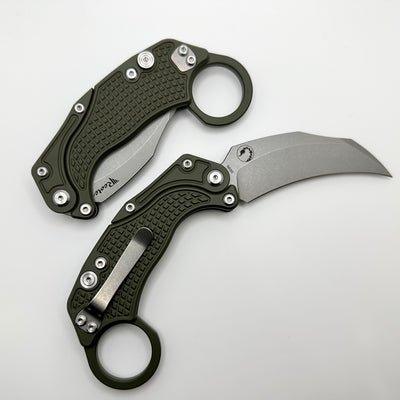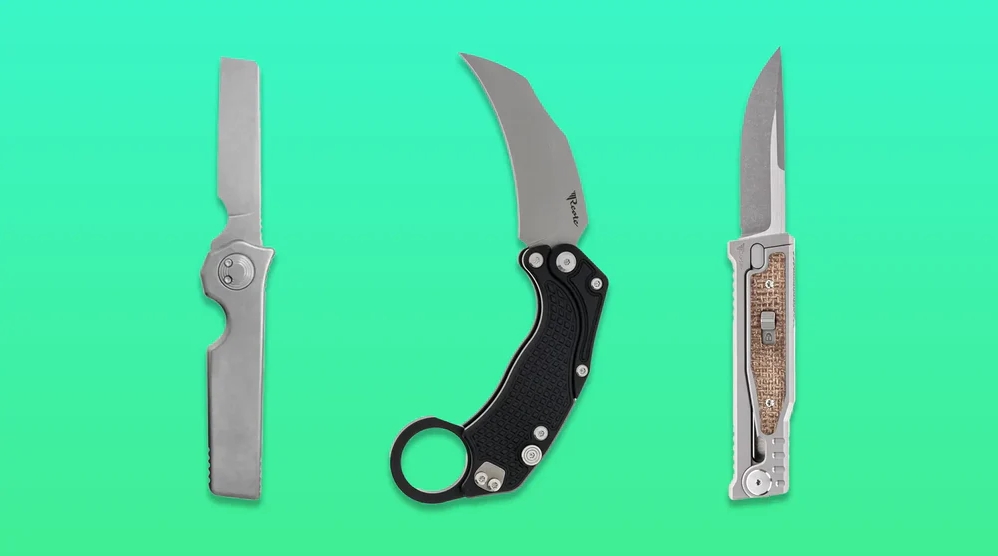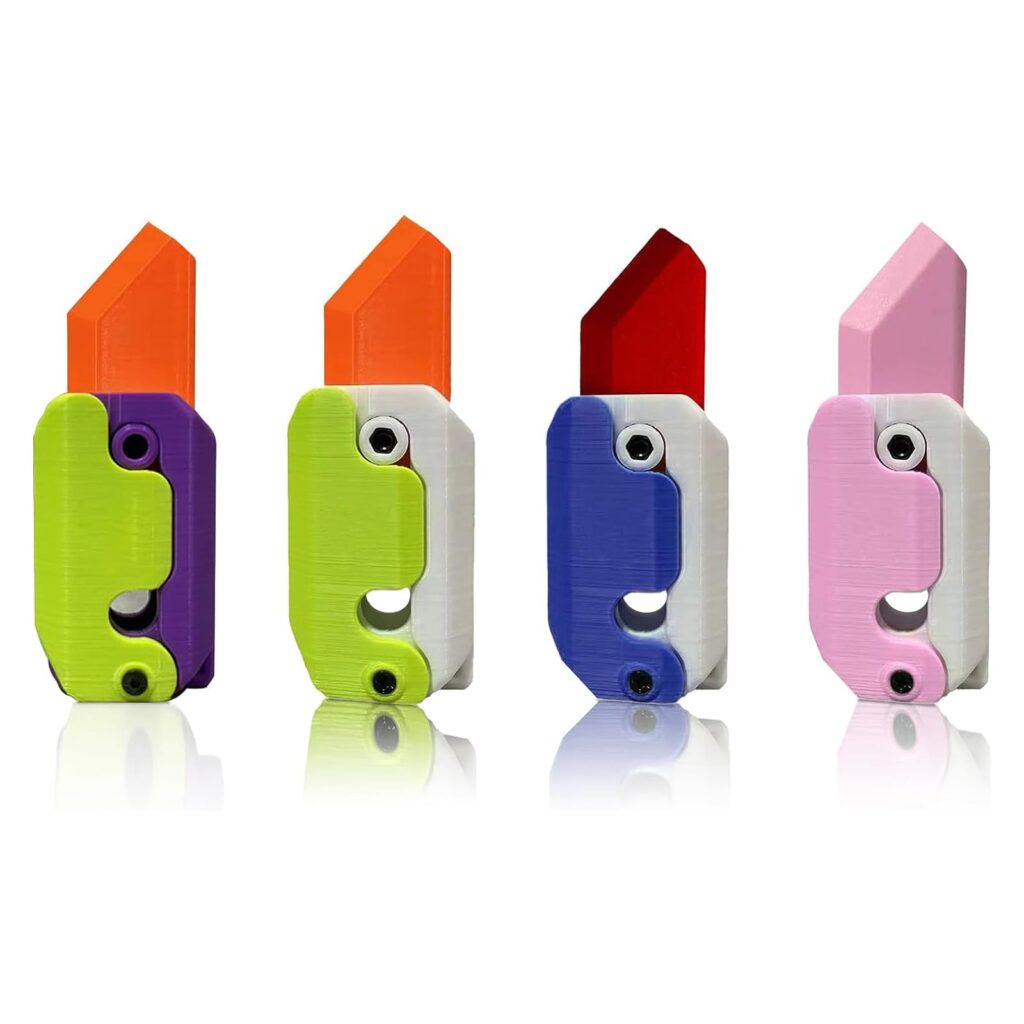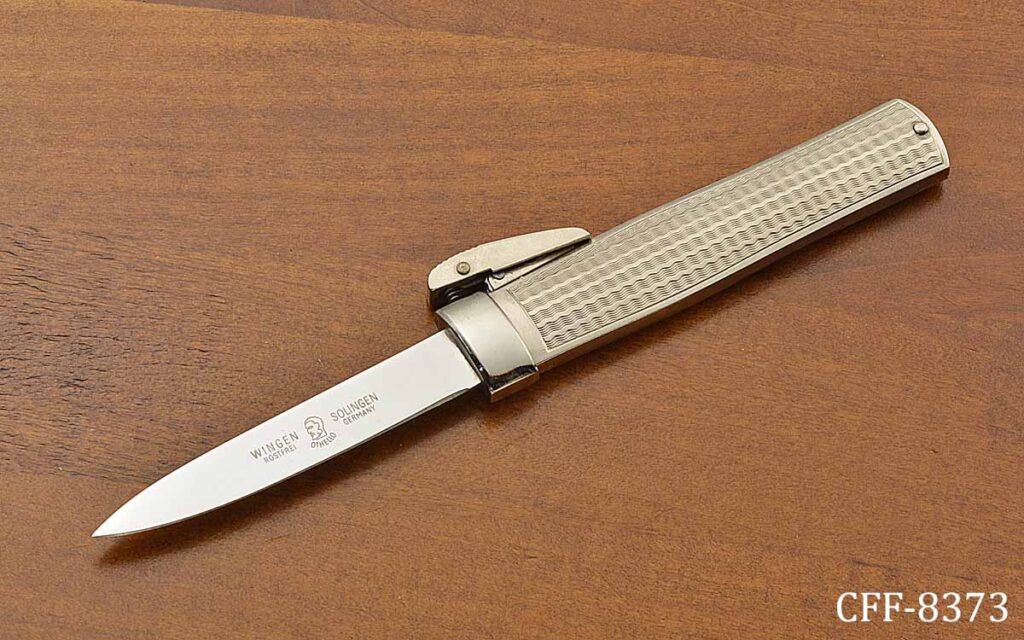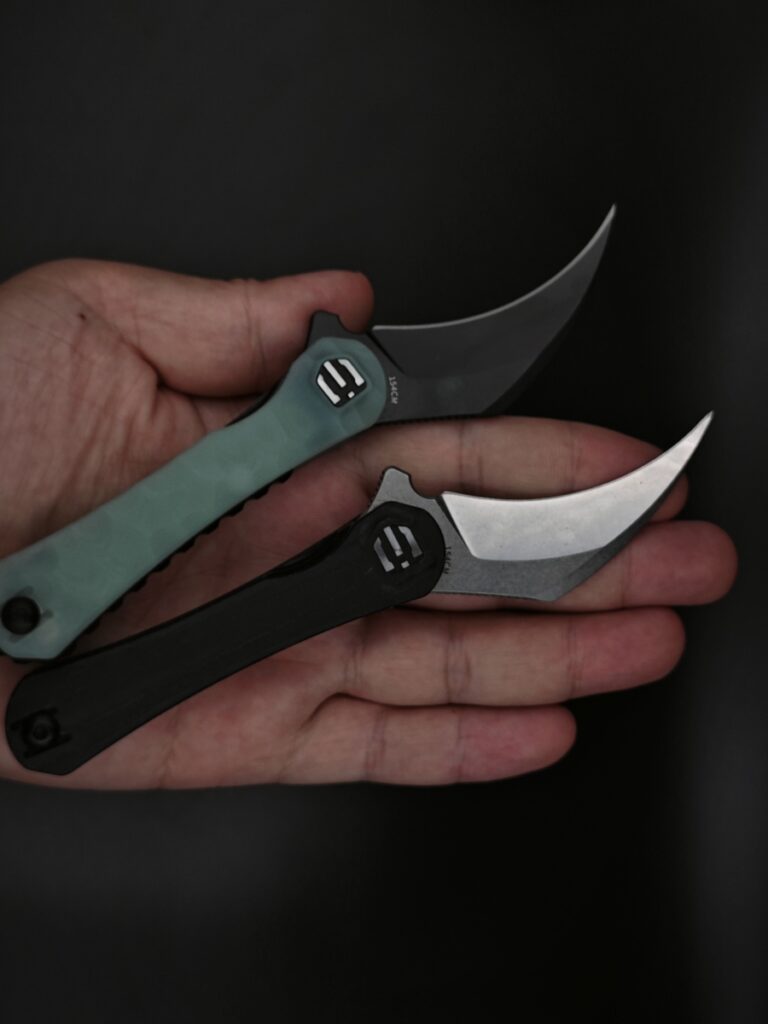In today’s rapid commercial and industrial scenes, being efficient and precise isn’t just nice to have—it’s a must. For example, a gravity knife is a tool that’s shaking things up with its aesthetic design and functionality, proving its worth in all sorts of business settings.
A gravity knife has a blade hidden inside the handle, and it opens with the force of gravity.
Unlike a switchblade, which pops open automatically with a button or lever press, a gravity knife works differently. Its main benefit is that you can open it with one hand, which is handy when your other hand is busy.
From making tasks easier with its unique mechanism to boosting cutting accuracy, the gravity knife is turning out to be a game-changer in anyone’s professional toolkit looking to step up their game.
This article is all about highlighting how handy a gravity knife can be, detailing its uses across different fields. Whether you’re building things, running a warehouse, or leading outdoor adventures, getting how gravity knives can up your efficiency game is key.
We’re here to break it down for you, offering insights and a look at how gravity knives are making waves in various industries, making sure you’re ready to make the most of this innovative tool.
Technical Principles of Gravity Knives
Learning how gravity knives work shows us why they’re becoming essential tools in many professions.
These principles not only reflect ingenious engineering but also demonstrate how such tools can enhance operational efficiency and precision.
Working Principles of Gravity Knives
Gravity knives leverage a simple yet effective mechanism enabling blade deployment through the force of gravity or inertia.
Unlike traditional folding knives, which may require two-handed operation or thumb pressure to open, gravity knives are designed for quick, one-handed use.
This feature proves particularly useful in situations where speed and ease of access are paramount.
For example, if a firefighter gets tangled in wires during a rescue operation, they can quickly use a gravity knife with one hand to cut through the obstruction, allowing for a fast and safe rescue.
Design Innovations and Their Impact
Gravity knife design has evolved to enhance user safety, improve cutting accuracy, and increase efficiency.
Features like locks that secure the blade when it’s open or closed, comfortable handles and various blade options make these knives more useful for everything from work tasks to outdoor activities.
- Ergonomic Handles: Designed to fit comfortably in the user’s hand, reducing fatigue during prolonged use.
- Locking Mechanisms: Ensure the blade stays in place during use, preventing accidental closures that could lead to injuries.
- Versatile Blade Types: Allow users to select a blade best suited for their specific task, whether it requires a serrated edge for cutting through ropes or a fine edge for precision slicing.
Trends in Gravity Knife Technology and Future Potential
The gravity knife industry is constantly innovating, focusing on better materials, sustainability, and adding smart features. Now, we’re seeing knives made from lightweight yet strong materials like carbon fiber or titanium, making them easier to handle.
There’s also a push towards eco-friendly production to reduce their environmental impact.
Apart from tactical use, a trend this 2024 has come up with a plastic gravity knife similar to a fidget spinner, which is gaining popularity among office workers as a stress-relieving tool.
Moreover, there are talks of integrating smart technology into gravity knives, such as sensors for tracking usage and maintenance needs.
As the world becomes more connected and efficient, it’s not hard to imagine how these advancements could further revolutionize the use of gravity knives in various industries.
Applications in Business Sectors
Manufacturing Sector Efficiency
In manufacturing, gravity knives have significantly streamlined production lines, offering both safety and precision during operations.
For instance, in automotive assembly plants, workers frequently need to open packaging or cut through materials quickly and safely. Gravity knives enable them to do so without diverting attention from their primary tasks, increasing workflow efficiency.
A good example is the automotive manufacturing unit, where gravity knives have been incorporated into assembly lines to improve the speed and safety of producing electric vehicles.
By reducing the time spent on auxiliary tasks, the automotive industry has achieved a more streamlined production process, enhancing overall productivity.
Construction Industry Enhancements
Gravity knives have been a game-changer in the construction world, making things smoother and safer on-site. Being able to whip out a cutting tool with just one hand is a big deal when you’re juggling efficiency and safety.
This way, workers can keep one hand free to steady themselves or handle other tasks, cutting down on accidents and ensuring their cuts and measurements are spot-on.
Specialized Applications Across Industries
Beyond the more obvious applications, gravity knives have found their niche in specialized industries, including medical, aerospace, and emergency services, due to their precision and reliability.
In emergency medical services, for instance, paramedics use gravity knives for quickly cutting through clothing or seatbelts in critical life-saving situations.
Similarly, in aerospace maintenance, technicians utilize these tools for intricate tasks that require both precision and speed, ensuring that meticulous maintenance can be conducted swiftly and without compromise.
This adaptability across diverse fields underscores the gravity knife’s invaluable contribution to enhancing operational efficiency and safety standards industry-wide.
Opportunities and Challenges in the B2B Market for Gravity Knives
Key Considerations for Business Users
When choosing gravity knives for work, businesses need to think about a few key points to make sure the knives meet their needs.
These points include how long the knives last, how comfortable they are to hold and use, their safety features, and the types of blades they have.
For instance, a construction company might look for strong knives with safety locks to avoid accidents, while a packaging company might want knives that can easily cut through various materials.
It’s also important to pick knives from reputable manufacturers known for quality and good customer service to ensure they last a long time.
Competitive Advantages in the Market
Gravity knives are a game-changer in the B2B market, especially where speed, safety, and efficiency matter most.
Their easy one-handed use not only makes the workplace safer by cutting down on injuries but also speeds up work, helping get tasks done faster.
For example, in emergency services, being able to quickly use a knife can save lives, putting gravity knives a step ahead of traditional cutting tools.
Thanks to their innovative designs and use in various industries, from healthcare to aerospace, gravity knives have become essential tools.
Potential Challenges and Solutions
Gravity knives have their advantages, but they also face several issues like strict regulations, a crowded market, and misunderstandings about their use.
Regulations can make them hard to find in some places, so there’s a need for clear rules and support for their use in work settings.
To stand out in a saturated market, makers should keep innovating, maybe by adding smart tech to their products.
To clear up any misconceptions, it’s important to educate people on how gravity knives can be safely and effectively used in professional contexts, moving away from any negative stereotypes.
Customization Services: Meeting Diverse Industry Needs
Customization is crucial for meeting the specific needs of various industries, making gravity knives more useful and attractive in the B2B market.
By offering custom options such as different blade types, handle materials, and extra features like logos or special safety features, suppliers can meet their clients’ precise requirements.
For example, Shieldon, which specializes in outdoor tools like pisau EDC, and more, could release gravity knives tailored for medical emergency kits and other fields.
These knives would be easy and safe to use in urgent situations, improving emergency medical services.
Introduction to SHIELDON’s Services
Shieldon, renowned for its expertise in outdoor knowledge and tools, is perfectly positioned to meet the diverse demands of the B2B market for gravity knives.
Their commitment to quality, coupled with comprehensive customization options, allows them to serve a wide range of industries effectively.
Whether businesses require knives for precise medical emergencies, rugged construction sites, or intricate aerospace maintenance, Shieldon’s services can be tailored to meet and exceed these demands, laying down the foundation for a safer, more efficient operational landscape.
Industry Collaboration and Innovation
Collaborative Business Strategies
The partnership between gravity knife manufacturers and their business clients is important.
Together, they work on strategies to make products more functional and safer.
This cooperation often includes detailed discussions, designing products to meet specific needs, and ongoing feedback to ensure the final product is just right.
For example, a construction company might work with a manufacturer to create a knife with a special grip that works better in wet conditions, reducing accident risks and improving safety.
This kind of teamwork means products are not just innovative but also specifically designed to tackle real-world challenges, raising the bar for industry-specific tools.
Cross-Industry Innovation through Gravity Knife Technology
Gravity knife technology could drive innovation in many industries. Its versatility and usefulness can lead to new products that also offer one-handed operation, which enhances safety and efficiency.
Examples include:
- In medical devices, incorporating gravity knife technology into surgical tools could allow for quicker adjustments during procedures, improving patient outcomes.
- In wearable tech, embedding miniature gravity knives in safety wearables for first responders can provide them with an easily accessible tool in emergencies.
These innovations show that gravity knife technology is driving product development across different industries, creating a space where both safety and efficiency are key priorities.
The Role of Collaborative R&D in Industry Competitiveness
Collaborative research and development (R&D) projects involving gravity knife manufacturers and different industry stakeholders play a key role in moving the industry forward.
These partnerships can result in:
- The creation of safer, more efficient cutting tools through shared expertise.
- The introduction of advanced materials and ergonomic designs that improve the user experience and durability.
- The development of smart gravity knives equipped with IoT technology for better tracking and management of tools on large construction sites or in emergency services.
For example, a collaborative R&D project between a tech company and a manufacturer could result in a gravity knife that not only automatically retracts when not in use but also sends maintenance alerts, significantly enhancing safety and operational efficiency.
These partnerships are foundational to maintaining competitiveness, as they drive innovation, meet evolving market demands, and address specific challenges faced by industries reliant on cutting tools.
Safety Regulations and Compliance
Understanding Safety Standards for Gravity Knives
To safely use gravity knives, it’s important to fully understand the required safety standards.
Businesses using these knives must keep up with the rules for their use.
This means knowing the right way to handle, store, and keep them in good condition to avoid accidents.
Doing regular safety checks can greatly reduce injury risks. Also, it’s smart to train all employees using gravity knives on the proper use and safety practices.
Navigating Regulatory Requirements Across Borders
Gravity knives are subject to different regulatory requirements, depending on the country or region.
This variation in laws means that businesses must be diligent in understanding the legal framework within their operating areas.
For example, some regions might restrict the usage or carrying of gravity knives without specific permits, while others may have more lenient regulations.
A practical approach is to consult with legal experts who specialize in weapon regulations to gain a clear understanding of what is required.
Additionally, businesses can create a compliance checklist that covers all necessary legal aspects, ensuring they operate within the law at all times.
Ensuring Industry Standards and Legal Compliance
Adhering to industry standards and laws is not just about avoiding legal repercussions; it’s about ensuring the safety and reliability of the tools being used.
Businesses should seek to exceed the minimum requirements by adopting best practices in tool safety and compliance.
This could mean using gravity knives that come equipped with safety features beyond the industry norms or implementing an internal audit system to regularly review compliance levels.
By going above and beyond in terms of compliance, businesses can demonstrate their commitment to safety, potentially inspiring trust and loyalty from their customers and partners.
Kesimpulan
The use of gravity knife technology is transforming safety and efficiency across industries, from construction to emergency services.
These tools are proving to be extremely versatile and are setting new benchmarks for what’s possible.
Understanding and adopting this technology is essential for any business that wants to perform at its best.
At Shieldon, we’re leading the charge by offering customizable gravity knife solutions tailored to our client’s specific needs.
Whether improving safety with knives that can be operated with one hand or incorporating smart tech for better tool management, our team is ready to help turn your ideas into reality.
With Shieldon, the sky’s the limit. Keeping up with the latest in gravity knife technology means not just following but leading.
Frequently asked questions
What are the key differences between traditional spring-assisted knives and gravity knives in terms of functionality and usability?
The key differences between traditional spring-assisted knives and gravity knives primarily lie in their mechanisms of operation and ease of use.
Traditional spring-assisted knives require manual force applied to a part of the blade or a button to open, with a spring mechanism then completing the action.
This provides a quick yet controlled blade deployment. Gravity knives, on the other hand, utilize the force of gravity or a flick of the wrist to allow the blade to slide out of the handle.
This design enables a faster and often one-handed operation, enhancing usability, especially in situations where speed and efficiency are crucial. Consequently, gravity knives offer superior ease of use in many scenarios, albeit with a need for careful handling to ensure safety.
What are the main challenges that businesses face when implementing gravity knife technology, and how can these be overcome?
The main challenges businesses face when implementing gravity knife technology include compliance with varying legal regulations, ensuring the safety of users, and integrating advanced features while maintaining ease of use.
These challenges can be overcome by:
- Staying Informed and Compliant: Businesses must actively stay updated on and comply with all regulatory requirements in their area of operation. Regular consultations with legal experts can provide insights into navigating the complex legal landscape.
- Prioritizing Safety: Implementing comprehensive safety training programs for all employees who will be handling gravity knives is crucial. Businesses should also consider investing in models equipped with advanced safety features.
- Utilizing Expert Partnerships: Collaborating with manufacturers and tech companies specializing in gravity knife technology can help businesses incorporate innovative features that enhance usability without compromising safety or legal compliance.
By addressing these challenges proactively, businesses can effectively leverage gravity knife technology to enhance operational efficiency, safety, and compliance.
How do regulations and legal restrictions vary across different countries regarding the use and distribution of gravity knives, and what implications do these have for international trade?
Regulations on gravity knives differ globally due to varying legal and cultural views, with some countries imposing bans or requiring permits and others being more lenient but regulating public carry.
Businesses engaged in international trade must develop a robust legal compliance strategy to navigate these laws, including specific import, export, and distribution regulations.
Non-compliance can lead to fines, confiscation, and reputational damage, making thorough legal research and local partnerships crucial for compliance and effectiveness.
What are some of the most innovative applications of gravity knife technology in non-traditional fields such as art, design, or entertainment?
Gravity knife technology has found its way into art, design, and entertainment, showcasing versatility and innovation in these fields.
Artists and designers are using the accuracy and ease of use of gravity knives for detailed work, such as intricate paper cutting and creating complex designs in materials like leather or canvas.
In the world of entertainment, particularly in stage productions and film, gravity knives are used for their realistic appearance and safe operability, adding authenticity to performances without compromising safety.
How is the development of gravity knife technology driving broader trends in industrial design, and what can we learn from these advancements for other tool innovations?
The development of gravity knife technology is influencing broader trends in industrial design by prioritizing ergonomics, safety, and efficiency in tool manufacturing.
This emphasis on user-friendly design, integrating technology for enhanced functionality, sets a precedent for future tool innovations.
By learning from these advancements, industries can develop tools that are not only more effective and safer to use but also adaptable to various environments and tasks.

